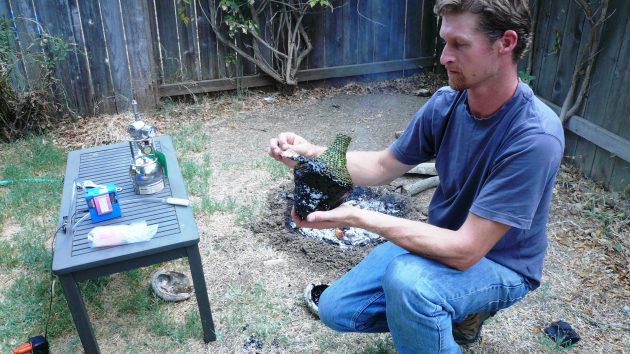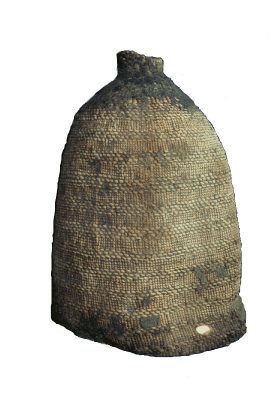By Devin Reese

Sabrina Sholts, Smithsonian research anthropologist and curator of physical anthropology, with a reference skeleton and a femur from an individual who suffered from rickets. [Terry Collection P000826-0] (Photo by Paul Fetters)
People lived on the California Channel Islands beginning at least 13,000 years ago and invented increasingly sophisticated technologies to adapt to their environment over time. Faced with unstable climates and growing populations, their survival depended on storing drinking water to cope with drought periods. Stored water also allowed them to make extended canoe trips to search for food and other resources necessary for survival.
Archaeological evidence shows that by at least 5,000 years ago, they were making water vessels by coating baskets with a natural sticky tar called bitumen. The tar is common on beaches in the oil-rich Channel Islands region, washing ashore from underwater seeps or oozing from cracks in the ground. Bitumen was collected, traded, and used by these Native Americans who were later known as the Chumash and the Gabrielino Indians.
Bitumen mainly consists of chemical compounds known as polycyclic aromatic hydrocarbons (PAHs). Today, we get exposed to PAHs from fossil fuel burning, cigarette smoking, road paving, and other burning and uses of petroleum products. PAHs are implicated in various health problems, from hormone disruptions to developmental abnormalities and cancer. The authors note that “the adverse health effects of PAHs on modern humans are well-established, but their health impacts on past populations are unclear.”

Study co-author Kevin Smith of the University of California, Davis, applies melted bitumen to a woven grass bottle. Instruments on the nearby table test for toxins in the air. (Photo by Sabrina Sholts)
Is it possible that chronic exposure to PAHs from bitumen damaged the health of Native Channel Islanders?
“Adverse effects of PAH exposure can sometimes manifest directly in the skeleton as poor bone quality, gross abnormalities or reduced stature,” says study lead author Sabrina Sholts. An earlier study of skeletal remains led by co-author Sebastian Wärmländer of the University of California, Santa Barbara, showed decreases in height and head size, along with signs of poor health, as bitumen use ramped up.

Traditional Chumash twined basketry bottle. (Image courtesy Santa Barbara Museum of Natural History)
Were the increasing levels of PAH exposure toxic enough to contribute to the observed skeletal changes?
The researchers decided to project themselves back in time, recreate conditions, and estimate levels of PAH exposure. Based on archaeological evidence and historical records, they pieced together the process of making bitumen-coated bottles. In replicating it, they used raw materials from the Channel Islands and mainland coastal regions where California Indians once lived.
First, they wove grasses into a basketry framework. Then they heated bitumen over a fire until it liquefied. Pouring multiple times, they swirled melted bitumen with hot pebbles to coat the inside of the bottle. Next, the outside was coated, and the bottle was rotated over the fire to smooth the bitumen into a waterproof layer.
Two Chumash-style bottles were completed using traditional techniques. PAH levels were measured in air, while bitumen was melted onto the baskets, and also in olive oil and water stored in the coated baskets. Although native Californians did not have olives, olive oil is a good proxy for oily substances. Samples of the liquids were then taken over two months to test for concentrations of 16 PAHs considered to be “priority pollutants” by the U.S. Environmental Protection Agency.

Ph.D. student and study co-author Cecilia Wallin of the Department of Biochemistry and Biophysics at Stockholm University pours olive oil into a Chumash-style bottle replica. (Photo by Sebastian Wärmländer)
How did the traditional water bottle do by modern health standards? PAH concentrations in the water samples were not high enough to pose significant human health risks. However, high concentrations of PAHs did leach into the olive oil, suggesting that fatty foods cooked or stored in bitumen-coated containers could have become contaminated. The smoke from melting bitumen also contained harmful PAH levels, a bit higher than in cigarette smoke. People making water bottles may have been doing the equivalent of chain smoking.
Native Californians used bitumen for other tasks: sealing boat hulls, gluing arrowheads onto shafts, setting broken bones, and decorating skin. Bitumen’s use and health impacts in all of these applications remain to be investigated.
Other cultures, such as the ancient Egyptians, used bitumen for various purposes, including mummification. Understanding such uses in the broader context of human history and evolution may inform our decisions about the risks of chemical exposure going forward.





